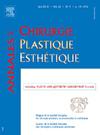乳房再造后敏感性:不同方法的比较。
IF 0.5
4区 医学
Q4 SURGERY
引用次数: 0
摘要
背景与目的:乳房面积敏感性是评价乳房重建术后生活质量的关键因素。乳房感觉可以使用许多已经在文献中大量描述的工具进行评估,包括最常用的Semmes Weinstein细丝。虽然不同的重建技术是可用的,后br灵敏度很少被描述。本研究的目的是根据各种重建技术来评估乳房术后的敏感性。材料与方法:每组15例,共90例:BR前、背阔肌瓣联合种植体、背阔肌瓣联合脂肪移植术、单纯脂肪移植术、上腹部下深穿支(DIEP)瓣、种植体。一位评估者用Semmes Weinstein灯丝测试了两侧的7个区域来评估敏感性。原生乳房被认为是控制。收集了各种潜在的混杂因素。结果:与其他组(DIEP瓣)相比,单纯BR联合脂肪移植术的患者重建乳房的感觉明显更好(p)。结论:我们比较了不同BR技术的乳腺敏感性。我们的研究首次比较了所有主要乳房重建方法的乳房敏感性。脂肪移植在延迟乳房重建术中的乳房敏感性优于植入物或皮瓣BR。本文章由计算机程序翻译,如有差异,请以英文原文为准。
Breast sensibility after reconstruction: Comparison of different methods
Background and objectives
Sensibility of the breast area is a key factor in quality-of-life evaluation after breast reconstruction (BR). Breast sensation can be assessed using numerous tools that are already largely described in the literature, including the Semmes Weinstein filaments which remain the most frequently used. Although different reconstruction techniques are available, post-BR sensitivity is rarely described. The aim of this study was to evaluate post-BR sensibility of the breast according to each reconstruction technique.
Material and methods
Fifteen patients were included in each group, i.e. 90 patients in total: before BR, Latissimus Dorsi (LD) flap with implant, LD flap with fat grafting, exclusive fat grafting, Deep Inferior Epigastric Perforator (DIEP) flap, implant. A single evaluator assessed the sensibility with Semmes Weinstein filaments testing 7 zones on both sides. The native breast was considered as control. Various potential confounding factors were collected.
Results
Patients who benefited from BR with fat grafting alone had a significantly better sensation of the reconstructed breast compared to the other groups (DIEP flap (P < 0.0001), LD flap + implant (P = 0.0013), LD flap with fat grafting (P = 0.0073), implant (P = 0.00315)). Comparing those results to the ones obtained in the group before reconstruction, only the fat grafting and DIEP flap groups showed a difference, the fat grafting group (P = 0.0061) had higher sensibility whereas DIEP flaps were less sensitive (P = 0.00233).
Conclusion
We compared mammary sensibility depending on the BR technique used. Our study is the first comparing breast sensitivity among all major breast reconstruction methods. Fat grafting resulted in better breast sensitivity in delayed breast reconstruction than implant or flap-based BR.
Contexte et objectifs
La sensibilité est un élément important mais sous-estimé, dans l’évaluation de la qualité de vie après une reconstruction mammaire (RM). La sensibilité du sein peut être évaluée à l’aide de nombreux outils déjà largement décrits dans la littérature, dont les filaments de Semmes Weinstein, qui restent les plus fréquemment utilisés. Il existe depuis longtemps de nombreuses techniques de reconstruction, mais la sensibilité post-RM est rarement évaluée. L’objectif de cette étude était d’évaluer la sensibilité mammaire post-RM en fonction de chaque technique de reconstruction.
Matériel et méthodes
Quinze patientes ont été incluses dans chaque groupe, soit un total de 90 patientes: avant RM, lambeau de grand dorsal avec implant, lambeau de grand dorsal avec greffe de graisse, greffe de graisse exclusive, DIEP, implant. Le même évaluateur a quantifié la sensibilité avec des filaments de Semmes Weinstein en testant 7 zones de chaque côté. Le sein natif a été considéré comme témoin. Divers facteurs de confusion potentiels ont été recueillis.
Résultats
Les patientes ayant bénéficié d’une RM avec greffe adipeuse seule avaient une sensibilité significativement meilleure du sein reconstruit par rapport aux autres groupes (lambeau DIEP [p < 0,0001], lambeau LD + implant [p = 0,0013], lambeau LD avec greffe de graisse [p = 0,0073], implant [p = 0,00315]). En comparant ces résultats avec ceux obtenus dans le groupe avant reconstruction, seuls les groupes greffe de graisse et lambeau DIEP ont montré une différence, le groupe greffe de graisse (p = 0,0061) ayant une sensibilité plus élevée, tandis que les lambeaux DIEP étaient moins sensibles (p = 0,00233).
Conclusion
Notre étude est la première à comparer la sensibilité du sein entre les principales techniques de reconstruction mammaire. La greffe adipeuse est celle qui permet de préserver la meilleure sensibilité mammaire post-reconstruction différée par rapport aux reconstructions par implants ou lambeaux.
求助全文
通过发布文献求助,成功后即可免费获取论文全文。
去求助
来源期刊
CiteScore
1.00
自引率
0.00%
发文量
86
审稿时长
44 days
期刊介绍:
Qu''elle soit réparatrice après un traumatisme, pratiquée à la suite d''une malformation ou motivée par la gêne psychologique dans la vie du patient, la chirurgie plastique et esthétique touche toutes les parties du corps humain et concerne une large communauté de chirurgiens spécialisés.
Organe de la Société française de chirurgie plastique reconstructrice et esthétique, la revue publie 6 fois par an des éditoriaux, des mémoires originaux, des notes techniques, des faits cliniques, des actualités chirurgicales, des revues générales, des notes brèves, des lettres à la rédaction.
Sont également présentés des analyses d''articles et d''ouvrages, des comptes rendus de colloques, des informations professionnelles et un agenda des manifestations de la spécialité.

 求助内容:
求助内容: 应助结果提醒方式:
应助结果提醒方式:


